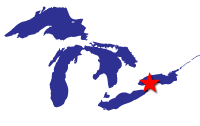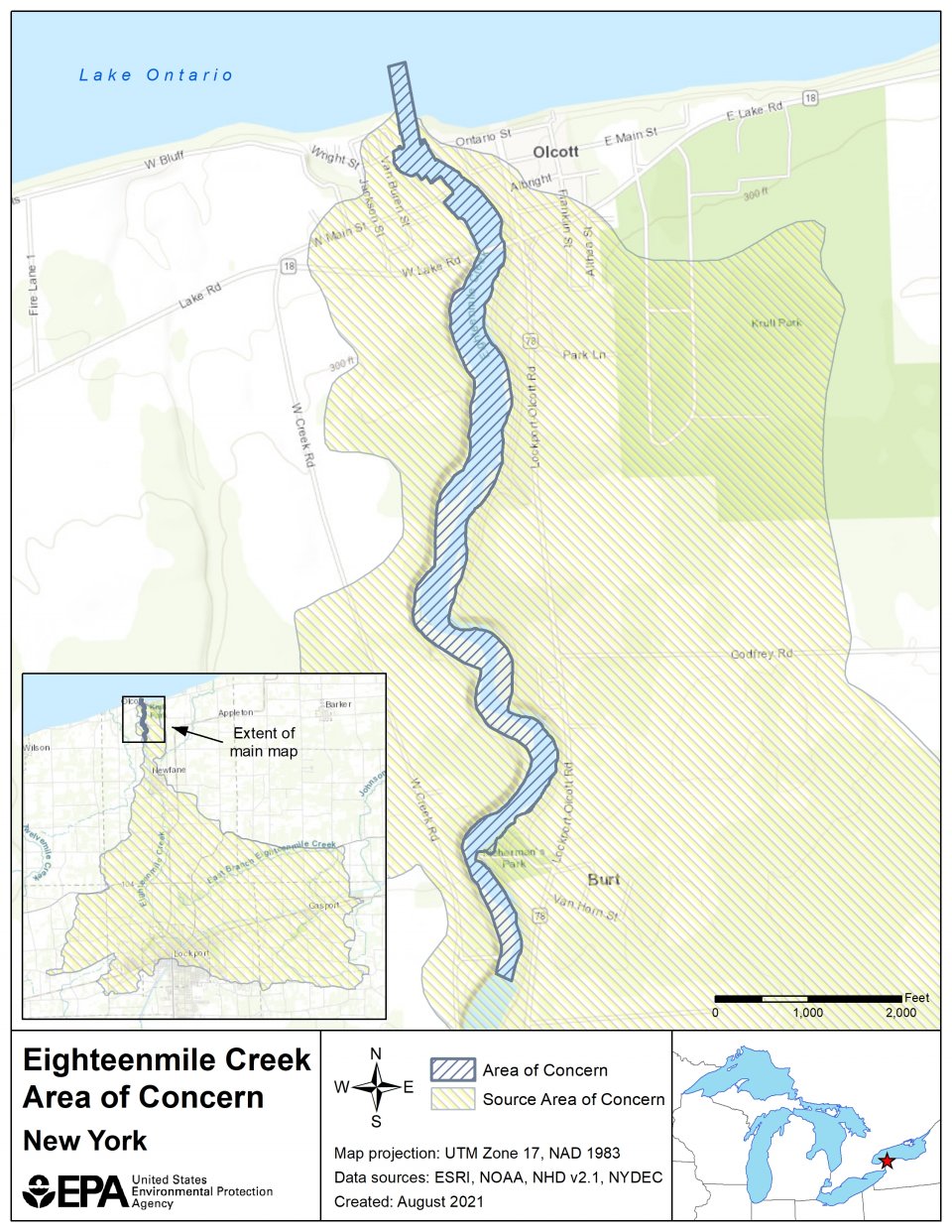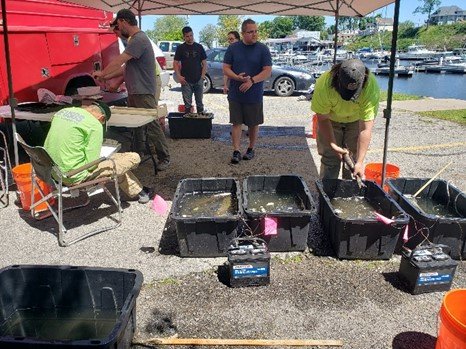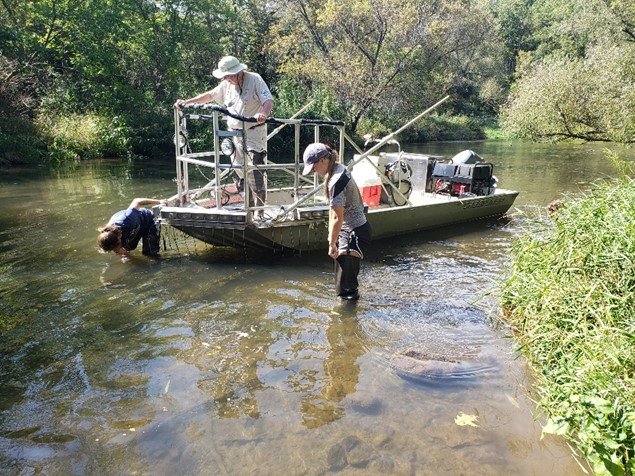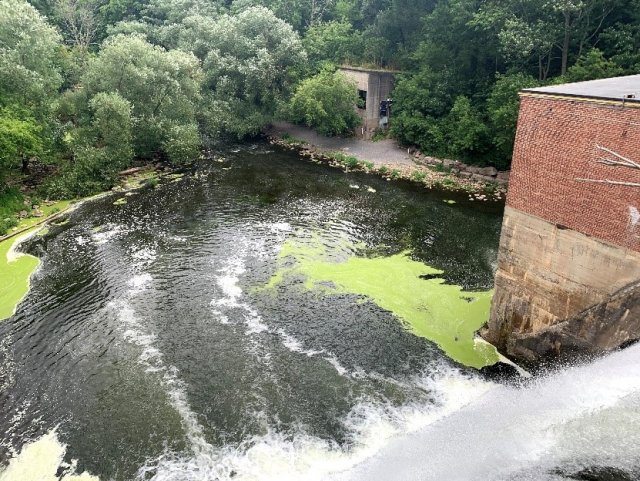Eighteenmile Creek AOC
Christopher Seslar
(Seslar.Christopher@epa.gov)
212-637-3810
On this page:
Overview
The Eighteenmile Creek Area of Concern (AOC) is in western New York State along the southern shore of Lake Ontario in Niagara County. The AOC encompasses the lower portion of Eighteenmile Creek, from the base of Burt Dam to Olcott Harbor at the outlet to Lake Ontario.
This portion of Eighteenmile Creek was designated as an AOC under the Great Lakes Water Quality Agreement in 1987 because of poor water quality and sediment contamination by former industrial and municipal discharges, waste disposal and pesticide usage.
In 2020, the U.S. Army Corps of Engineers (USACE) did an extensive assessment of fish, toxicity, and sediment data to determine the necessity of management actions to delist this AOC. The analysis concluded that the main contaminant driving the Beneficial Use Impairments (BUIs) impairments within the AOC are PCBs from an upstream source area, outside of the AOC boundaries. Testing results indicated that the sediment within the AOC is below the toxicity threshold. The existing elevated levels of PCBs found in tissue samples of fish were concluded to be a result of contamination upstream of Burt Dam, an area which is undergoing cleanup activities through EPA’s Superfund program. As a result of these findings, USACE recommended that sediment remediation within the AOC was not warranted.
The AOC program will continue to fund monitoring projects to measure environmental improvements related to the Superfund cleanup and provide data necessary to remove BUIs. The Eighteenmile Creek AOC does not have any management actions to implement.
Beneficial Use Impairments
Beneficial Use Impairments, or BUIs, are designated when the AOC was originally listed and are indicators of significant environmental degradation. The Eighteenmile Creek AOC has five of the potential 14 BUIs shown below. BUIs are removed when measurable environmental health improvements have been demonstrated and certain BUI removal criteria are met. The list below shows which BUIs have been removed and which remain. Once all BUIs are removed, the process of delisting the AOC can begin.
- Restrictions on Fish and Wildlife Consumption
- Degradation of Fish and Wildlife Populations - Removed September 2024
- Bird or Animal Deformities or Reproduction Problems
- Degradation of Benthos
- Restrictions on Dredging Activities – Removed September 2020
General information about BUIs: Beneficial Use Impairments for the Great Lakes AOCs
Remediation and Restoration Work
Superfund
In March of 2012, EPA placed Eighteenmile Creek on the Superfund program’s National Priorities List (NPL) due to the extent of contamination. The Superfund cleanup will remove sources of contamination throughout the creek to meet specific remedial objectives. Some portions of the cleanup have begun. Although the primary contaminant source is upstream of the AOC, fine-grained suspended material can be transported over Burt Dam where it may settle out in the AOC. Due to this, the Superfund program is also investigating potential contamination occurring within the AOC.
Monitoring Project Highlight: Fish Community Survey
This study looked at fish population abundance and fish community structure within Eighteenmile Creek and compared it to a reference site, Oak Orchard Creek. In June 2019, a team of USGS, New York State Department of Environmental Conservation (NYDEC), NYS Museum Ichthyology Lab and Niagara County Soil and Water Conservation District (NCSWCD) sampled over 1000 fish from Eighteenmile Creek and Oak Orchard Creek. The researchers assessed fish weight as an indicator of individual fish health, and species diversity, as an indicator of the overall health of the creek. Based on the results, the fish from both locations did not have significant differences. This project is a positive step in meeting the fisheries component of the Degradation of Fish and Wildlife Populations BUI removal criteria. A peer review journal article of this assessment has been written by USGS, NYSDEC and NCSWCD to be published in a future issue of the Journal of Great Lakes Research.
Monitoring Project Highlight: Mink Study
In 2018, SUNY Brockport started a study to assess the status of two BUIs and their effects on wildlife within the Eighteenmile Creek AOC. The results found no reproductive or physical impairments for birds, fish, amphibians or reptiles. However, for mammals, initial research suggested potential reproductive issues for the study species, mink. In previous studies, mink have been shown to be especially sensitive to PCBs, dioxins and furans, contaminants found in Eighteenmile Creek AOC. These contaminants can cause reproductive failure. To determine if contaminants of concern were at high enough levels to cause reproductive problems or deformities within mink populations in the AOC, mink were caught, and tissue sampled. Data from various prey species and water samples were modeled to estimate the impact in the AOC, upstream, and in the unimpacted Oak Orchard site. Samples were collected in Fall 2018, Spring 2019, Summer 2019, Fall 2019 and Spring 2020. Preliminary results suggest there may be impairments.
- Degradation of Fish and Wildlife Populations
- Bird or Animal Deformities or Reproduction Problems
Monitoring Project Highlight: NYSDEC Fish Tissue Analysis
In the fall of 2018, NYSDEC collected 52 fish samples from Eighteenmile Creek for the Toxic Substance Monitoring Program. The fish collected were all popular sportfishing species and were a mixture of resident fish and Lake Ontario fish that reside in Eighteenmile Creek for short periods of time for spawning. The Brown Trout, Chinook Salmon, Coho Salmon or Rainbow Trout (steelhead) collected from Eighteenmile Creek, which are fish expected to be from Lake Ontario, did not exceed the Department of Health (DOH) guideline for a specific PCB advisory. These results show that PCB concentrations in the resident Largemouth Bass did exceed the DOH guideline for a specific advisory. The data has been shared with NYSDOH for review and there is no change to the fish consumption advisory for Eighteenmile Creek AOC.
This project monitors the following BUI:
- Restrictions of Fish and Wildlife Consumption
Monitoring Project Highlight: PCB Study Using Semi-Permeable Membrane Devices
In August of 2020 and March of 2021, EPA worked with U.S. Army Corps of Engineers to deploy passive water samplers into the Eighteenmile Creek AOC. This project was designed to gather better information regarding the current flow of PCBs into the AOC from upstream, gather further information to refine the mink assessment for the removal of Degradation of Fish and Wildlife Populations BUI and to generate water quality data to further determine where the main source of PCBs is in the AOC. Prior assessment by USACE concluded that the accumulation of PCBs in fish appears to be mainly driven by high concentrations from upstream sources. Water samplers were deployed at five locations throughout the Eighteenmile Creek AOC and the reference site, Oak Orchard Creek. This study provided data necessary to inform future removal of BUIs in the AOC.
Partners
The following links exit the site

